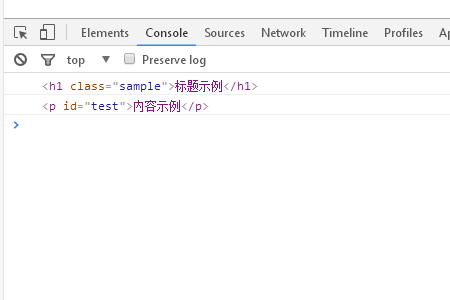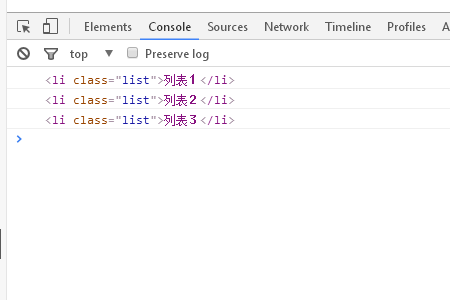 Web Front-end
Web Front-end
 JS Tutorial
JS Tutorial
 Introduction to the method of querySelector() in JavaScript to obtain HTML elements
Introduction to the method of querySelector() in JavaScript to obtain HTML elements
Introduction to the method of querySelector() in JavaScript to obtain HTML elements
QuerySelector() is a method that can detect and obtain any HTML element from JavaScript. Although JavaScript has had methods such as getElemenById() and getElemetnsByClasNamo() to obtain HTML elements from the beginning, if you use querySelector(), Then you can selectively specify HTML elements in the jQuery sense without knowing the id attribute value, class attribute value, etc.

#In short, you can use querySelector() to retrieve any HTML element.
Let’s first look at the basic syntax of querySelector()
querySelector() will usually be executed on the target range.
document.querySelector( CSS选择器 )
In this case querySelector() will be executed on the entire document. Arbitrary HTML elements can be obtained by specifying jQuery-like CSS selectors for parameters.
It should be noted that the program will end when it obtains the first matching HTML element.
In other words, if you want to get multiple elements, you need to create a loop process, or use what we will talk about later querySelectorAll().
Let's continue to seeHow to use querySelector()?
Get the HTML element with ID and Class attributes
The example is as follows
HTML
<h1 class="sample">标题示例</h1> <p id="test">内容示例</p>
JavaScript
var elem1 = document.querySelector('.sample'); var elem2 = document.querySelector('#test'); console.log(elem1); console.log(elem2);
The running results are as follows

You can see that each parameter of querySelector() specifies a CSS selector.
Thus, the same querySelector() can also obtain any HTML element according to the parameter specification method.
It can be seen from the execution result that the element has been obtained.
Let’s look at how to use querySelectorAll()
querySelectorAll() can get multiple HTML elements.
Let’s take a look at its basic syntax first
document.querySelectorAll(CSS选择器)
In this way, the method and target range of specified parameters are the same as querySelector().
The biggest difference is that you can get all matching HTML elements!
Since queryselector() can only retrieve the first matching element, we can use querySelectorAll() to get multiple elements.
Let’s look at a specific example
HTML code
<ul> <li class="list">列表1</li> <li class="list">列表2</li> <li class="list">列表3</li> </ul>
In this example, multiple list elements are arranged.
To retrieve all elements of this list, you can do the following
JavaScript
var elem = document.querySelectorAll('.list'); console.log(elem);
In this example, the class attribute value "list" is specified as the parameter of querySelectorAll() .
This will specify all list elements, so all list items can be obtained.
Of course, you can set the "li" element as is, but be careful about balancing it with other list elements.
The elements obtained by querySelectorAll() are called NodeList, which stores a data structure similar to an array.
Below we use 'forEach' to process one element at a time, which can effectively process the array repeatedly.
var elem = document.querySelectorAll('.list');
elem.forEach(function(value) {
console.log(value);
})The running results are as follows

In this example, the results obtained using querySelectorAll() are looped by the forEach statement.
By specifying the parameter "value", each HTML element can be obtained like the above results.
Note: You can perform arbitrary processing on HTML elements obtained using querySelectorAll()!
The above is the detailed content of Introduction to the method of querySelector() in JavaScript to obtain HTML elements. For more information, please follow other related articles on the PHP Chinese website!

Hot AI Tools

Undresser.AI Undress
AI-powered app for creating realistic nude photos

AI Clothes Remover
Online AI tool for removing clothes from photos.

Undress AI Tool
Undress images for free

Clothoff.io
AI clothes remover

Video Face Swap
Swap faces in any video effortlessly with our completely free AI face swap tool!

Hot Article

Hot Tools

Notepad++7.3.1
Easy-to-use and free code editor

SublimeText3 Chinese version
Chinese version, very easy to use

Zend Studio 13.0.1
Powerful PHP integrated development environment

Dreamweaver CS6
Visual web development tools

SublimeText3 Mac version
God-level code editing software (SublimeText3)

Hot Topics
 What should I do if I encounter garbled code printing for front-end thermal paper receipts?
Apr 04, 2025 pm 02:42 PM
What should I do if I encounter garbled code printing for front-end thermal paper receipts?
Apr 04, 2025 pm 02:42 PM
Frequently Asked Questions and Solutions for Front-end Thermal Paper Ticket Printing In Front-end Development, Ticket Printing is a common requirement. However, many developers are implementing...
 Demystifying JavaScript: What It Does and Why It Matters
Apr 09, 2025 am 12:07 AM
Demystifying JavaScript: What It Does and Why It Matters
Apr 09, 2025 am 12:07 AM
JavaScript is the cornerstone of modern web development, and its main functions include event-driven programming, dynamic content generation and asynchronous programming. 1) Event-driven programming allows web pages to change dynamically according to user operations. 2) Dynamic content generation allows page content to be adjusted according to conditions. 3) Asynchronous programming ensures that the user interface is not blocked. JavaScript is widely used in web interaction, single-page application and server-side development, greatly improving the flexibility of user experience and cross-platform development.
 Who gets paid more Python or JavaScript?
Apr 04, 2025 am 12:09 AM
Who gets paid more Python or JavaScript?
Apr 04, 2025 am 12:09 AM
There is no absolute salary for Python and JavaScript developers, depending on skills and industry needs. 1. Python may be paid more in data science and machine learning. 2. JavaScript has great demand in front-end and full-stack development, and its salary is also considerable. 3. Influencing factors include experience, geographical location, company size and specific skills.
 How to merge array elements with the same ID into one object using JavaScript?
Apr 04, 2025 pm 05:09 PM
How to merge array elements with the same ID into one object using JavaScript?
Apr 04, 2025 pm 05:09 PM
How to merge array elements with the same ID into one object in JavaScript? When processing data, we often encounter the need to have the same ID...
 Is JavaScript hard to learn?
Apr 03, 2025 am 12:20 AM
Is JavaScript hard to learn?
Apr 03, 2025 am 12:20 AM
Learning JavaScript is not difficult, but it is challenging. 1) Understand basic concepts such as variables, data types, functions, etc. 2) Master asynchronous programming and implement it through event loops. 3) Use DOM operations and Promise to handle asynchronous requests. 4) Avoid common mistakes and use debugging techniques. 5) Optimize performance and follow best practices.
 How to achieve parallax scrolling and element animation effects, like Shiseido's official website?
or:
How can we achieve the animation effect accompanied by page scrolling like Shiseido's official website?
Apr 04, 2025 pm 05:36 PM
How to achieve parallax scrolling and element animation effects, like Shiseido's official website?
or:
How can we achieve the animation effect accompanied by page scrolling like Shiseido's official website?
Apr 04, 2025 pm 05:36 PM
Discussion on the realization of parallax scrolling and element animation effects in this article will explore how to achieve similar to Shiseido official website (https://www.shiseido.co.jp/sb/wonderland/)...
 The Evolution of JavaScript: Current Trends and Future Prospects
Apr 10, 2025 am 09:33 AM
The Evolution of JavaScript: Current Trends and Future Prospects
Apr 10, 2025 am 09:33 AM
The latest trends in JavaScript include the rise of TypeScript, the popularity of modern frameworks and libraries, and the application of WebAssembly. Future prospects cover more powerful type systems, the development of server-side JavaScript, the expansion of artificial intelligence and machine learning, and the potential of IoT and edge computing.
 The difference in console.log output result: Why are the two calls different?
Apr 04, 2025 pm 05:12 PM
The difference in console.log output result: Why are the two calls different?
Apr 04, 2025 pm 05:12 PM
In-depth discussion of the root causes of the difference in console.log output. This article will analyze the differences in the output results of console.log function in a piece of code and explain the reasons behind it. �...





